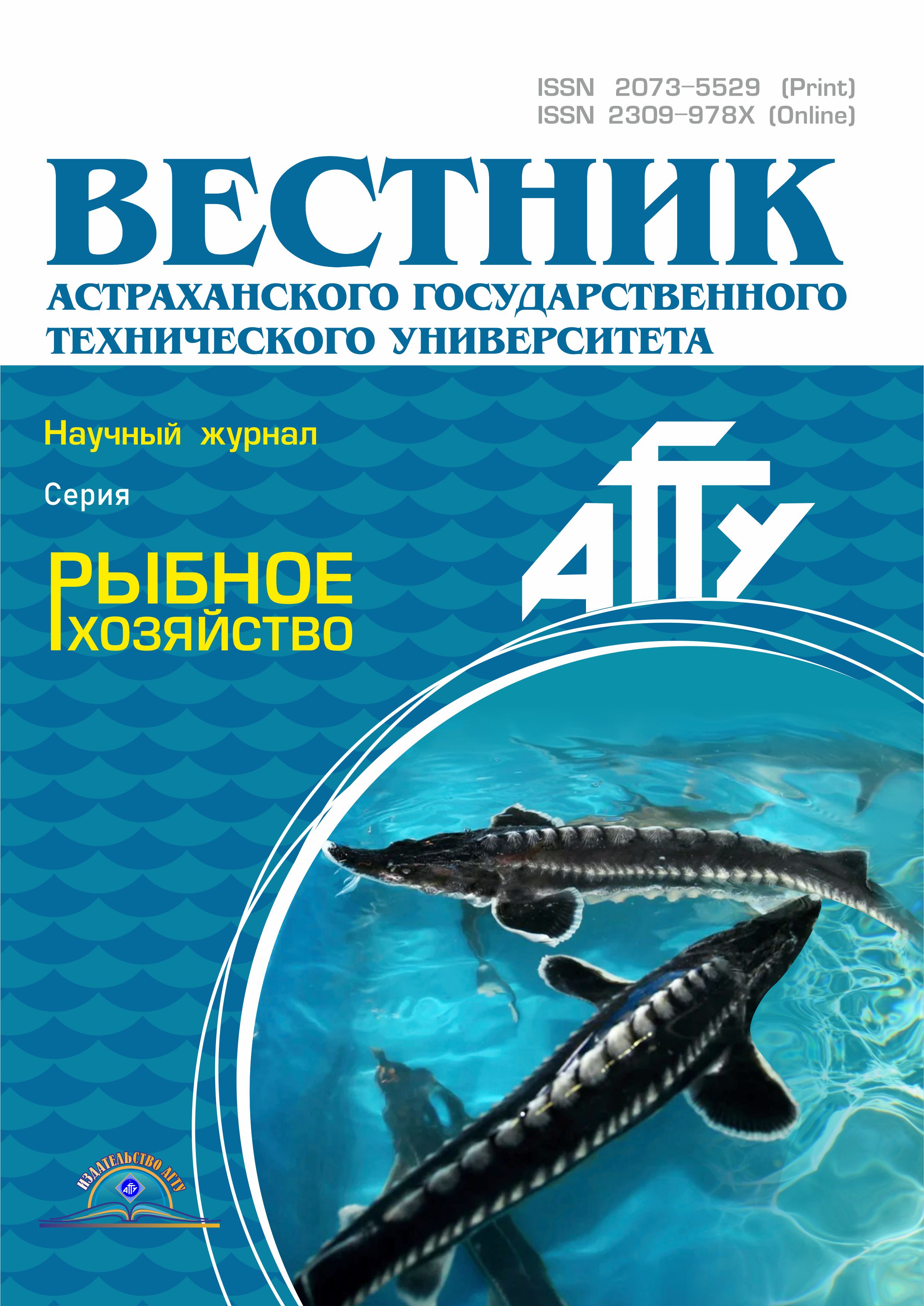CSCSTI 34.39
CSCSTI 62.13
CSCSTI 69.01
CSCSTI 69.25
CSCSTI 69.31
CSCSTI 69.51
CSCSTI 87.19
The purpose of the research was to study accumulation of mercury and selenium in muscles and liver of Russian and Persian sturgeons caught in the Caspian Sea. Analysis of the data revealed preferential accumulation of mercury and selenium in liver compared to muscle tissues of both species. The article shows that the degree of mercury accumulation in the liver and muscles of the Persian sturgeon was higher than of the Russian. Correlation analysis of data showed that mercury content in the sturgeon liver and muscles statistically significantly depended on age, length and weight of the fish. In the course of these studies there has been identified a direct correlation between selenium content in muscle tissue and body weight of fish. The results of the analysis indicate that the accumulation of mercury and selenium in Persian and Russian sturgeon species is stipulated by their physiological characteristics and properties of the chemical elements. Mercury concentration in liver and muscles of the tested species is little, which corresponds to the standards adopted in Russia. The level of selenium in the liver increases with the concentration of mercury in it, which confirms the defensive function of selenium against heavy metals.
mercury, selenium, Russian sturgeon, Persian sturgeon, Caspian Sea, bioaccumulation
1. Ivanov V. P. Biologicheskie resursy Kaspiyskogo morya. Astrahan': Izd-vo KaspNIRH, 2000. 100 s.
2. Vorob'ev V. I., Zaycev V. F., Scherbakova E. N. Biogennaya migraciya tyazhelyh metallov v organizme russkogo osetra (Acipenser gueldenstaedtii, Brandt). Astrahan': Izd-vo OOO «CNTEP», 2007. 115 s.
3. Moiseenko T. I. Rtut' v gidrosfere // Rtut' v biosfere: ekologo-geohimicheskie aspekty: materialy Mezhdunar. simpoz. (Moskva, 7-9 sentyabrya 2010 g.). M.: GEOHI RAN, 2010. S. 14-19.
4. Kamshilova T. B., Komov V. T., Gremyachih V. A. Soderzhanie rtuti i skorost' rosta okunya Perca fluviatilis iz ozer Vologodskoy oblasti // Rtut' v biosfere: ekologo-geohimicheskie aspekty: materialy Mezhdunar. simpoz. (Moskva, 7-9 sentyabrya 2010 g.). M.: GEOHI RAN, 2010. S. 277-281.
5. Nemova N. N., Komov V. T. Pokazateli biohimicheskogo metabolizma u presnovodnyh ryb s povyshennym soderzhaniem rtuti // Rtut' v biosfere: ekologo-geohimicheskie aspekty: materialy Mezhdunar. simpoz. (Moskva, 7-9 sentyabrya 2010 g.). M.: GEOHI RAN, 2010. S. 297-300.
6. Janz D. M. Selenium in Homeostasis and Toxicology of Essential Metals // Fish Physiol. 2012. Vol. 314. P. 327-374.
7. Ribeiro A. R. A., Ribeiro L., Saele O., Hamre K., Dinis M. T., Mjren M. Selenium supplementation changes glutathione peroxidase activity and thyroid hormone production in Senegalese sole (Soleasene galensis) larvae // Aquaculture Nutrition. 2012. Vol. 18, iss. 5. P. 559-567.
8. Nimta G., Valsa S. P., Subhas M. C. P. Physiologic implications of inter-hormonal interference in fish: Lessons from the interaction of adrenaline with cortisol and thyroid hormones in climbing perch (Anabas testudineus Bloch) // General Comp. Endocrinol. 2013. Vol. 181. P. 122-129.
9. Kekina E. G., Golubkina N. A., Kuz'mina V. V., Baranov V. I., Hotimchenko S. A. Soderzhanie yoda i selena v myshcah nekotoryh promyslovyh ryb Rybinskogo vodohranilischa // Mikroelementy v medicine. 2009. T. 10, vyp. 3-4. S. 31-36.
10. Kekina E. G., Golubkina N. A., Baranov V. I., Hotimchenko S. A. Morskaya ryba kak istochnik dieticheskogo yoda i selena // Mikroelementy v medicine. 2008. T. 9, vyp. 3-4. S. 67-72.
11. Golovanova I. L. Vliyanie rtuti na pischevarenie u zhivotnyh razlichnyh sistematicheskih grupp // Rtut' v biosfere: ekologo-geohimicheskie aspekty: materialy Mezhdunar. simpoz. (Moskva, 7-9 sentyabrya 2010 g.). M.: GEOHI RAN, 2010. S. 263-268.
12. Pastuhov M. V., Epov V. N., Cheshel'skiy T. M., Alieva V. I., Grebenschikova V. I. Raspredelenie i akkumulyaciya rtuti v baykal'skoy nerpe // Izv. Irkutsk. gos. un-ta. Ser.: Biologiya. Ekologiya. 2011. T. 4, № 1. S. 56-66.
13. Ivanov V. P., Komarova G. V. Ryby Kaspiyskogo morya (sistematika, biologiya, promysel). Astrahan': Izd-vo AGTU, 2008. 256 s.
14. Huang S. S-Y., Strathe A. B., Wang W-F., Deng D-F., J. G., Fadel. J. G., Hung S. S. O. Selenocompounds in juvenile white sturgeon: Evaluating blood, tissue and urine selenium concentrations in juvenile sturgeon after a single oral dose // Aquatic Toxicology. 2012. Vol. 109. P. 158-165.
15. Munkueva S. D., Golubkina N. A. Nakoplenie selena ryboy Buryatii // Voprosy pitaniya. 2003. № 3. S. 56-62.
16. Gashkina N. A., Moiseenko T. I., Kudryavceva L. P. Bioakkumulyaciya rtuti v organizmah ryb v vodoemah Evropeyskoy chasti Rossii // Rtut' v biosfere: ekologo-geohimicheskie aspekty: materialy Mezhdunar. simpoz. (Moskva, 7-9 sentyabrya 2010 g.). M.: GEOHI RAN, 2010. S. 258-263.
17. Golubkina N. A., Papazyan T. T. Selen v pitanii // Rasteniya, zhivotnye, chelovek. M.: Pechatnyy gorod, 2006. 256 s.
18. Wang D. The Environmental Biogeochemistry of Selenium in Natural Water Ecosystem. Publ. Nat. Public Health Inst., Helsinki, KTL A3, 1994. 244 p.
19. Komov V. T., Gremyachih V. A., Ershov P. N. Sravnitel'noe soderzhanie rtuti v myshcah ryb vodoemov severa Evropeyskoy Rossii (Kandalakshskiy zaliv Belogo morya) // Biologicheskie resursy Belogo morya i vnutrennih vodoemov Evropeyskogo Severa: materialy XXVIII Mezhdunar. konf. (Petrozavodsk, 5-8 oktyabrya 2009 g.). Petrozavodsk: Karel'skiy nauch. centr RAN, 2009. C. 289-292.
















